Examples of Formative Assessment: Enhancing Learning Through Effective Assessment Techniques

Formative assessment techniques, through their continuous and interactive nature, allow for enhanced learning by providing immediate feedback and personalized instruction, promoting active student engagement, and guiding targeted interventions. While these practices face challenges, their importance in creating a student-centered environment and boosting academic growth cannot be overlooked. Ultimately, formative assessments are pivotal in the academic journey, acting as key navigational tools to steer students’ understanding and learning success.
What Is a Formative Assessment?
Formative assessment is not limited to traditional tests or quizzes; it encompasses a range of techniques that enable teachers to gather evidence of student learning in diverse ways. These techniques can include classroom discussions, questioning, observations, student feedback, self-reflections, concept mapping, and the use of digital tools and apps, among others.
By embracing formative assessment practices, educators can create a dynamic and responsive learning environment that promotes active engagement, personalized instruction, and continuous improvement. Through the effective implementation of formative assessment techniques, teachers can provide valuable feedback and support to students, fostering academic growth and enhancing their overall learning experience.
Examples of Formative Assessment: Enhancing Learning Through Effective Assessment Techniques
Formative assessment plays a crucial role in learning, allowing educators to gauge students’ understanding and tailor instruction accordingly. By employing effective formative assessment techniques, teachers can enhance learning outcomes and promote student engagement. Examples of formative assessment may range from fun and fast activities during a lesson, to a deeper self-assessment at the end of a lesson, to many things in between. Knowing the different types of assessments, formative assessment strategies, and formative assessment tools will enhance the benefits of formative assessment.
Formative assessment encompasses a range of techniques that provide educators with valuable insight into student learning and understanding. These may include simple ways for students to answer questions, such as observing students give a thumbs up or thumbs down, encouraging collaboration through a think-pair-share or small-group activity, or multiple-choice questions or summaries at the end of class.
Whether or not teachers are using a hard-copy template assessment that students physically turn in or a simple observation, the best formative assessment techniques are those that provide real-time analysis and aid. These techniques are designed to be interactive, ongoing, and informative, allowing teachers to adapt instruction and support student progress effectively.
Classroom Discussions and Questioning
Teachers can assess students’ understanding by observing their participation, listening to their responses, and probing further with follow-up questions. This technique encourages critical thinking, facilitates peer-to-peer learning, and provides valuable feedback on student comprehension. For example, Socrative circles or Socrative seminars are a great way for teachers to observe student-led discussion about a topic.
Exit Tickets
Exit tickets, also sometimes called exit slips, are brief assessments administered at the end of a lesson or class period. They can be short quizzes, reflections, or open-ended questions. Exit tickets allow teachers to quickly gauge student understanding and identify any misconceptions or areas that require further clarification.
For example, while a college classroom may use something more advanced and technological like clickers for their exit tickets, K-12 classrooms may use something as simple as a sticky note for their exit tickets. For more elementary students, it may ask students to identify how well they felt about the day’s lesson by having them circle a smiley face expressing different emotions. This can help students begin identifying their understanding of content. Other common exit ticket questions may include two or three simple multiple choice questions from the lesson or more open ended questions like listing something they learned and something they have more questions about.
One-Minute Papers
One-minute papers are short written responses where students summarize their learning in one minute. This technique encourages students to reflect on their understanding and articulate key concepts or takeaways from the lesson. It provides insight into individual student comprehension, promotes metacognition, and helps teachers assess overall class understanding.
Peer Feedback and Peer Assessment
Peer feedback and peer assessment involve students providing constructive feedback to their classmates. This technique not only helps students develop critical evaluation skills but also allows them to engage actively in their own learning. By evaluating the work of their peers, students gain a deeper understanding of the subject matter and receive feedback from different perspectives.
Quizzes and Tests
Short quizzes and tests can be used formatively to assess student understanding and progress. These assessments can be conducted throughout a unit or lesson to identify areas of strength and weakness. Teachers can use the results to adapt instruction, provide additional support, and address any misconceptions or gaps in knowledge.
Concept Mapping
Concept mapping involves visually organizing and connecting key concepts or ideas. This technique allows students to demonstrate their understanding of relationships between concepts. By analyzing concept maps, teachers can gain insight into individual students’ understanding and identify any gaps or misconceptions.
Journals and Reflections
Journals and reflections provide students with opportunities to express their thoughts, ideas, and reflections on their learning. Teachers can review these journals to gain insight into students’ understanding, thought processes, and areas of interest. This technique promotes self-reflection, metacognition, and critical thinking skills.
Observations and Checklists
Teachers can use observations and checklists to assess student performance and progress during classroom activities, presentations, or group work. By systematically observing students’ behaviors, interactions, and demonstration of skills, teachers can gather data on individual and group performance, and provide feedback and support.
Portfolios
Portfolios are collections of student work that showcase their progress over time. By reviewing portfolios, teachers can assess student growth, identify strengths and areas for improvement, and provide targeted feedback. Portfolios provide a holistic view of student learning and can be used to encourage self-reflection and goal setting.
Characteristics of Effective Formative Assessment Techniques
Effective formative assessment techniques are essential tools in education, because they contribute significantly to student learning and academic growth. These techniques possess specific characteristics that make them powerful in gauging student understanding, providing feedback, and guiding instructional decisions.
Formative assessment, unlike summative assessment, occurs during the learning process and aims to gather evidence about student progress and comprehension. Formative assessment can offer a more low-stakes approach to monitoring student responses and student progress in a way that is less stressful for both students and teachers.
By providing students with more opportunities to practice their knowledge and skills, we are not forcing them to rely on a final high-stakes assessment to be the determining factor for a grade. When implemented effectively, formative assessment techniques exhibit key characteristics that enhance their impact on teaching and learning.
Continuous Monitoring
Formative assessment is an ongoing process that involves monitoring students’ progress throughout the learning journey. Rather than relying solely on periodic evaluations, teachers actively observe and assess students’ understanding on a day-to-day basis. This continuous monitoring allows for timely interventions and personalized support.
Feedback and Self-Reflection
Effective formative assessment provides constructive feedback to students, guiding them toward improvement. Feedback should be specific, actionable, and focused on learning objectives. This allows individual students to receive tailored feedback, which promotes differentiated instruction as well.
Active Engagement
Formative assessment techniques should actively engage students in the learning process. Students should be encouraged to participate, discuss, and reflect on their learning. This can be achieved through various strategies, such as classroom discussions, group activities, problem-solving tasks, and collaborative projects.
Flexibility
Effective formative assessment techniques allow for flexibility in adapting instruction to meet the diverse needs of students. Teachers should be responsive to students’ progress and adjust teaching methods accordingly. This may involve modifying instructional approaches, providing additional support or enrichment opportunities, or differentiating instruction based on individual learning styles and preferences.
Benefits of Using Formative Assessment Techniques
Formative assessment techniques have become an indispensable part of modern education due to their numerous benefits for students and educators. Dr. Ruth Kaminski states, “I think that teachers find assessment most useful and meaningful if it helps them to make decisions about the students that they teach. And the two decisions that …are actually pretty big ones: Which students need help and where?” Being able to answer these two questions about learners will not only help teachers with their overall lesson plans but will also help address any learning gaps in student understanding. This, in turn, will aid students in seeing more progress and success when it comes to learning outcomes.
When it comes to meaningful assessment and why it is crucial for reading success, Dr. Ruth Kaminski states, “Both your curriculum and your assessment should be informed by the body of research about what we know about how reading develops. That’s known these days as the science of reading.” All content areas can benefit from effective formative assessments, but especially literacy instruction.
These techniques offer valuable insight into student learning, promote personalized instruction, and enhance overall academic growth. By incorporating formative assessment into the teaching and learning process, educators can optimize student engagement, understanding, and success.
Enhanced Learning and Understanding
Using a variety of formative assessment techniques allows teachers to tailor instruction to meet individual student needs, address misconceptions, and provide targeted support. As a result, students develop a deeper understanding of the subject matter and are better equipped to apply their knowledge.
Personalized Instruction
A personalized approach helps ensure each student receives the necessary support, challenges, and resources to succeed. It promotes a student-centered learning environment where instruction is tailored to individual strengths, weaknesses, and interests.
Immediate Feedback
Immediate feedback enables students to take ownership of their learning and make informed decisions about their academic progress. Additionally, instant feedback allows educators to intervene and provide support when needed, preventing misconceptions from persisting.
Targeted Interventions
A proactive approach of targeted interventions helps prevent learning gaps from widening and ensures all students receive the necessary support to succeed. It enables educators to differentiate instruction, provide remedial resources, and offer additional challenges to extend learning for high-achieving students.
Improved Engagement and Motivation
Active engagement fosters a positive learning environment, enhances intrinsic motivation, and increases student confidence. By nurturing a sense of active involvement through formative assessments, educators also cultivate a stimulating and energetic learning environment, which leads to heightened motivation and a boost in student self-assurance. Through the integration of formative assessment techniques, educators can support students’ learning journeys, facilitate their progress, and empower them to achieve success.
Conclusion
Formative assessments are essential components of a classroom due to their potential to optimize teaching and learning. They empower teachers to understand students’ learning needs, adjust their instructional strategies, and differentiate instruction to meet individual student requirements. Because of this, formative assessments have the ability to transform a student’s learning and redirect them on the right path of understanding. Voyager Sopris Learning® strives to support teachers with education solutions, especially when it comes to assessing reading, writing, and mathematics.
For example, our Acadience® suite of formative assessments provide universal screening and progress monitoring for reading in grades preK–8 and math in grades K–6. These assessments measure the acquisition of critical skills and help identify students who may be at risk for reading or math difficulties. Acadience helps educators identify areas to target instructional supports, monitors at-risk students as they receive targeted instruction, and informs the effectiveness of school and district systems of instructional support. Learn more about how Acadience helps improve student outcomes here.
